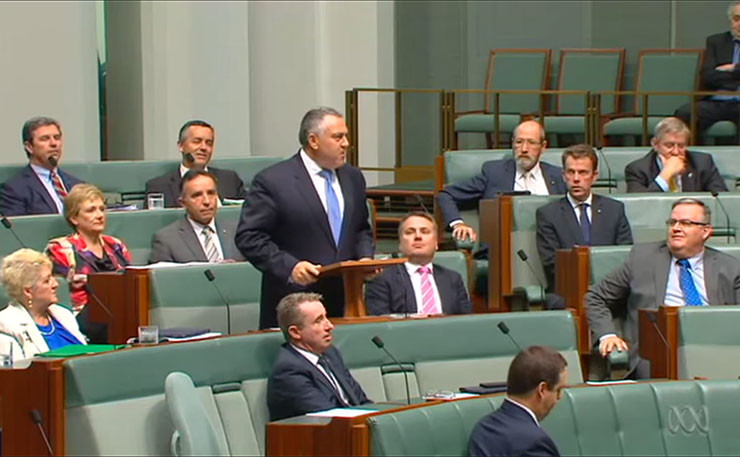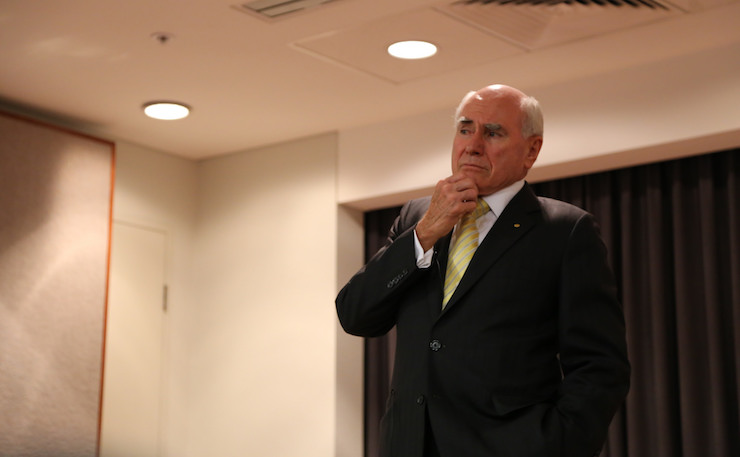The Coalition’s current turbulence is often contrasted with the supposedly stable years of the Howard government. But almost a decade after his demise, the Battler of Bennelong has cursed his own Party. The more the Liberals mythologise and attempt to emulate John Howard, the harder it will become to clean up the mess he left them in, writes Sean Hosking.
The recent celebration of the 20-year anniversary of the election of the Howard government offered a rare occasion for the Liberal Party to bask in the glow of what some have represented as a golden age of political governance in Australia. The night was distinguished by lashings of Champagne, vigorous back slapping, and Peter Costello’s smirk, which hadn’t had such a good night out since budget night 2007.
Party faithful competed to outdo each other in unrestrained praise of the greatness of Howard and his government which was now accorded equivalent status in the Liberal Party pantheon with the Menzies government. As Malcolm Turnbull put it in one of many exuberant flourishes, the gathering involved a reunion of “Bradman’s invincibles” who delivered “one of the greatest periods of prosperity our nation has ever known”.
Fortunately, or unfortunately depending on where your political allegiances lie, by the next day the euphoria of the night had given way to a media coverage that primarily focused on pictures of Tony Abbott sitting in uncomfortable proximity to a decidedly nervous looking Malcolm Turnbull. Overseeing the two at the head of the table like a benevolent and wise old gnome from a political fairy tale was the guest of honour, John Howard.
The picture was poignant because, like any image captured behind the scenes, it conveyed some real insight into the tension within the contemporary Liberal Party and the overbearing legacy left by the mythology of the Howard Government. These tensions have come to a head in the policy paralysis of the Turnbull and Abbott governments. They arise in part from a fundamental misunderstanding of the Howard government and the means by which it was able to pursue its free market neo-liberal agenda while remaining electorally viable.
Generated in large part through the Murdoch Press, the myth of the Howard government is fast approaching that point of reification where it transcends critical analysis and becomes accepted truth. Notwithstanding the fact that Howard was only the second PM in Australian history to lose his seat, the narrative goes that he was a political wizard who pushed the nation further to the right, reconciled the Australian working class to the values and policy prescriptions of the competitive free market, transitioned Australia from an egalitarian to an aspirational nation, and delivered unprecedented economic prosperity. In other words, the Howard government demonstrated how a party of the hard right committed to the free market and the interests of capital could govern in an electorally potent way.
The problem with this is that, like most political myth making, it bears only a passing resemblance to reality. As Roland Barthes opined, the function of myth is to create a blissful clarity and natural justification without explanation or depth. While worshiping at the altar of the Howard Government is no doubt blissful, as evidenced by the excesses of the anniversary dinner, the aftermath for both the Liberal Party and the nation is turning out to be traumatic.
Putting down our glasses of Dom Pérignon for one moment, let’s consider the Howard legacy in more detail.
Howard is widely attributed with successfully promoting the neo-liberal reform agenda in a concerted and more electorally palatable way than the Keating government, whose largely technocratic economic discourse alienated large sections of the community and led in large part to Howard’s landslide election victory in 1996. He is also credited with getting Australia’s finances in order as evidenced by the nine budget surpluses delivered by his treasurer Peter Costello. Acknowledging this, Malcolm Turnbull in his anniversary speech referred to Howard’s “unrivalled consistency of purpose and strength of conviction” in transitioning the Australian economy and reshaping the nation.
The first major problem with this is that by 1996 most of the heavy lifting in terms of economic reform had already been done by the Hawke/Keating Government – the deregulation of the banks, floating of the dollar, substantive independence of the reserve bank, the ending of import quotas and virtual phasing out of tariffs were either achieved or underway prior to Howard taking office. Howard’s ultimate reform accomplishments during his eleven years of government were rather modest, extending not much further than the GST, formal independence of the reserve bank and the privatisation of various public utilities.
Indeed, what was most notable about Howard’s early phase of leadership was his lack of policy direction and his political desire to distance himself from Labor’s economic reform agenda.
By 1996 the gradual withdrawal of the state as a service provider, the deregulation of labour markets, constraints on real wage growth, the move to user-pays and privatised means of service provision, and the demands of a more deregulated labour market all had significant impacted on the lived experience of the Australian working and middle classes. Exhibiting the political opportunism that would be a feature of his leadership, Howard sought to exploit this disaffection for electoral advantage.
His populist criticism of Labor’s ‘elite agenda’ combined with his ‘relaxed and comfortable’ rhetoric of white picket fences, the sanctity of family and an emphasis on an enduring Australian identity, though ludicrously at odds with his (sotto voce) endorsement of radical free-market economic reform, served initially to reassure sections of the community that he was either opposed to change, or actively shielding the community from its worst effects.
For most of his first two terms, before his political fortunes were saved by circumstance, the unsustainable tensions generated through the inconsistency of this approach inflicted significant electoral damage, both in relation to the battlers he was meant to save, and the policy elites who wanted further economic reform.
One of Howard’s most notable attempts to resolve these tension was through the mythology of the aspirational citizen. Aspirationals were said to be upwardly mobile, independent, hard-working battlers bereft of the egalitarian character, welfare dependence and class based political identifications of the traditional Australian working class battler. As such they represented an attempt to shoehorn the values of the free market and political right onto the Australian working class. According to Howard, aspirationals didn’t resent the person driving the Rolls Royce because they thought that one day they’d be driving their own.
You don’t hear too often about the aspirational class anymore and there are several reasons for this, all of which represent realities that the Liberal Party is, even now, struggling to accept.
If aspirationals existed they were doing it tough. Increasing financial and time pressures, loss of job security, record levels of household debt, a declining wages share of national income, and rising social inequality in reality caused widespread concerns in regard to the impact that neo-liberal reforms were having on Australia’s national character and well-being. The extent of this disquiet was reflected in a special series of articles and editorial in the Australian in the year 2000 that identified widespread discontent in the “shattering of the myths of the classless society, the egalitarian society, the fair go society”, all of which it said “were entirely unsustainable now”.

Despite the rhetoric about the Howard years representing a fundamental shift in national values, as Joe Hockey and Tony Abbott found out after the 2014 budget, the public’s allegiance to traditional egalitarian values of fairness and equity remained strong. A cursory glance at the results from the Australian Election Survey over the Howard period show trends in popular opinion in relation to unions, big business and the distribution of wealth more in line with the views of the ‘leftist chattering classes’ so derided by the populist political right in Australia.
It is therefore not surprising that for most of the first two terms of the Howard government its stocks were chronically low. Howard won the 1998 election by the slimmest of margins, having attempted to restore his reformist credentials by advocating for a GST, and by mid-2001 he was hopelessly behind in the opinion polls and heading toward defeat at the election later that year. It is widely acknowledged that his fortunes radically changed following the Tampa incident and the terrorist attacks of Sept 11.
The reality is that political disaster was averted due to in large part to economic factors out of Howard’s control. These factors were the booming global economy that followed the Unites States treasury’s decision to radically slash interests rates in late 2001 and the associated resources boom that flooded government coffers with an unprecedented financial windfall.
And it is in relation to this financial windfall that the second major component of Howard Government mythology, its fiscal competence, collapses.
In flagrant defiance of his small government, free market, anti-welfare rhetoric Howard immediately set about using this financial windfall and the additional finances gleaned from the sale of public utilities to restore his government’s political stocks by showering money into the Australian community.
Thus while the Howard government continued to pursue the hard right agenda of a more punitive and scaled down social welfare system in relation to disadvantaged minority groups such as the unemployed, the disabled, and Indigenous groups – contrary to neo-liberal ideology – the overall welfare net was extended rather than retracted following the post 2001 economic boom. For the period 1998 to 2008, the total dollar amount of Australian Government spending grew by 54 per cent and by 2004, 39 per cent of all families were effectively receiving more income support from government than they were paying tax.
For Howard, the privatised free market could only be sustained by massive public subsidies. The character and extent of the mostly non-means tested middle class welfare that followed was unprecedented: subsidies to private schools, health care rebates that ‘rewarded’ people taking out private health insurance, child care rebates that coincided with a shift to privately owned for-profit child-care centres, one off cash payments following the birth of a child, and an array of family benefit payments.
By 2007, Howard’s departure from free-market neo-liberal orthodoxy was so comprehensive that no less a figure than Murdoch columnist Janet Albrechtsen was moved to lament Howard’s betrayal of conservative principles, writing that “surreptitiously the politics of aspiration” was being “replaced with the politics of government dependency.” More recently the IMF has stated that the period 2003 – 2007 represented one of the most profligate periods of governance in Australian history.

Where did this leave Howard’s much heralded, hard-working, independent aspirational citizens. Well it left them as welfare dependent as any of the poor unfortunate ‘dole bludgers’ or ‘malingerers’ who routinely feature on the front page of the Murdoch tabloids. The Howard legacy is one of dependency, not just of the poor and disadvantaged who were scapegoated and stigmatised for much of his period of governance, but the heavily indebted, time pressed, middle classes increasingly reliant on two incomes and government largesse to stay solvent.
And, as the current budget deficit now blows out to 46 billion dollars, it is this largesse and the social expectations engendered by it that are coming back to haunt the current Coalition government. Perhaps this is what Turnbull meant when he told Howard at the anniversary dinner that “as a nation we will be forever in your debt.”
The tendency to draw the wrong lessons from the Howard government explains in part the disaster of the 2014 Hockey budget which owed a lot to Costello’s fetishisation of budget surplus’ and the Howard government blueprint of gouging downward to achieve budget savings. Rather than dismantle Howard’s middle class welfare and preferential tax treatment of the well off, Hockey, cigar in mouth, took the axe to the unemployed, senior citizens, students, people with disabilities and low income earners. Believing this was some kind of heroic display of fiscal rigour, and without Costello’s fistful of dollars to sweeten the deal, Hockey was then mortified to find himself confronted by a lynch mob citing the kind of egalitarian values that the political right thought Howard had dealt with long ago.
The distorted reading of the Howard years also explains in part the incessant tax cutting mantra of the political right who appear ideologically impervious to economic circumstance. While other countries such as Norway stashed away their one off windfall gains in multibillion dollar wealth funds, Howard squandered our resources windfall on seven successive tax cuts that are now estimated to be costing the budget 30 billion a year. Despite this, and the consequent budget black hole that has led to an estimated 80 billion dollar shortfall in health and education funding, the Coalition remains ideologically committed to providing further tax cuts and insisting that Australia has a spending and not a revenue problem.
In light of this the degree of cognitive dissonance in the right’s deification of Howard is simply astonishing and can only be explained in terms of the mind bending properties of mythology which omits inconvenient truths, like fiscal profligacy, and gives disproportionate weight to irrelevant factors, such as political longevity and boom time budget surpluses.
It can also be explained by Howard’s purges of the moderate ‘wet’ faction in the Liberal Party, which has left it effectively captured by a hard right faction who are as ideologically blinkered as their soul mates in the US Republican party. For ideologues, reality runs a long last to dogma, even when reality is biting you on the back side.
Consider Howard’s reputation if the politically fortuitous events of 2001 did not occur and, as appeared likely at the time, he was bundled out of office in his second election as prime minister. What would his legacy have been?
It would be a legacy that would be profoundly more instructive to the current Coalition Government. It would be a legacy that illustrated that Australia remains an egalitarian country and that regressive policies that strike at the heart of traditional values of fairness and equity are toxic. It would be a legacy that suggests that governments need to balance the interests of the business sector with those of the general community, that ideology is not a blue print for political longevity, that government spending needs to be responsible and targeted, and that tax cuts cannot be used as a general cure for all social ills irrespective of the economic/budgetary climate.
The knowledge of this may have spared the nation from the grand delusions in play during the 2014 budget, and the subsequent excruciating manoeuvres by Turnbull to disencumber himself from the unpalatable responsibility of raising taxes in order to meet health and education funding shortfalls that themselves are in part a legacy of the Howard government.
It would also have spared us the unedifying sight of government ministers tripping over themselves to outdo each other in tribute to a government that economically had more in common with Warney’s charitable fund than Bradman’s batting.
Donate To New Matilda
New Matilda is a small, independent media outlet. We survive through reader contributions, and never losing a lawsuit. If you got something from this article, giving something back helps us to continue speaking truth to power. Every little bit counts.





